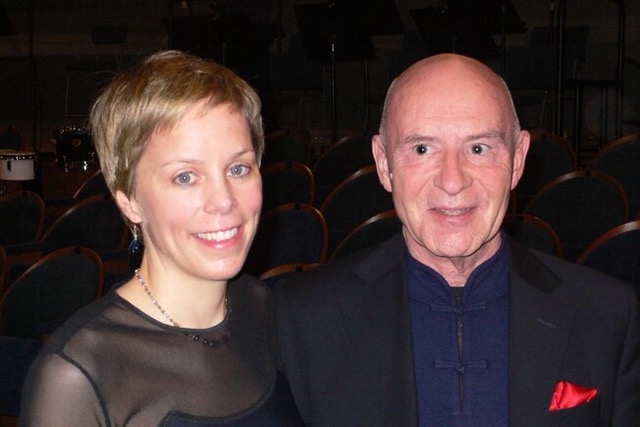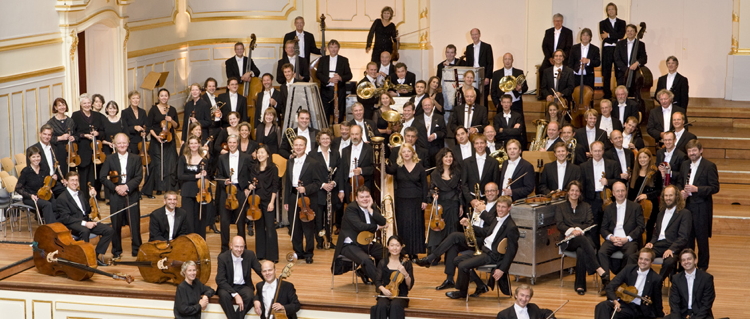solo soprano, SATB chorus, 2222/4.2Ctpt+1Bbpictpt.2.0/3 perc./1 harp/strings
Premiered by the Norddeutscher Rundfunk Orchestra, Christoph Eschenbach, conducting, 15 November 2002
Duration: 18 minutes or 5 minutes and 30 seconds because Movement #3: Blazing in Gold and quenching in Purple can be performed as a stand-alone composition.

Movement #3: Blazing in Gold and quenching in Purple, complete movement

Chanting to Paradise for solo soprano, chorus, and orchestra is a 15-minute work based upon texts by the American poet Emily Dickinson. It is scored for light lyric soprano, chorus, 2 flutes, 2 oboes (oboe #2 very briefly doubles English horn in F), 2 clarinets, 2 bassoons, 4 horns, 1 piccolo trumpet (briefly doubles trumpet in C), 2 trumpets in C, 2 trombones, 3 percussion [vibraphone (bow needed), suspended cymbal, xylophone, large woodblock, tubular chimes, glockenspiel, large tam-tam, bongo, medium triangle, small triangle, crotales (bow needed), bass drum, medium triangle, small triangle], harp, and strings.
Commissioned by NDR (North German Radio Orchestra), Chanting to Paradise is dedicated to Christoph Eschenbach and NDR with admiration and gratitude. The work's American premiere was presented in January 2003 by Christoph Eschenbach and the Philadelphia Orchestra.
Mozart is one of my musical heroes, and so it was with both nervousness and great joy that I accepted a commission from the North German Radio Orchestra to write a multi-movement companion piece to Mozart's sublime Requiem, his last work. Christoph Eschenbach had conceived a concert series for NDR in which "unfinished" works were to be paired with new compositions; my commissioned piece, entitled Chanting to Paradise, was to commence immediately after the first few bars of the "Lacrymose," exactly where Mozart had died while writing the Requiem. (Traditionally, Mozart1s Requiem is played in versions "completed" by other composers.)
The task required of me to fulfill this commission seemed challenging conceptually for many reasons. For what could I possibly compose that would be worthy to follow any bar of music that Mozart had written? And how does one start such a piece of music? What texts should I use? What formal scheme made sense, given that this piece was meant also to stand alone as an independent concert work? These and many other questions perplexed me as I began to compose Chanting to Paradise.
While I was grappling with all these musical issues, I reread the complete works of Emily Dickinson, another of my heroes. I selected about 30 poems of hers for possible inclusion in Chanting to Paradise, and ultimately used five of them. Dickinson was a prolific poet and her words — which are full of magic, tenderness, intimacy, a single-minded vision, spirituality, and grace — seemed to resonate with my conception of, and dreams about, this composition. I deeply respect her short, sparse, powerful texts, and seek to reflect them in my music.
Chanting to Paradise begins with the chorus quietly extending the many "oo" vowels in Mozart's final phrase: "qua resurget ex favilla judicandus homo reus." Humming almost inaudibly at first, the music seems to emanate from the perfume of Mozart's final earthly tones. From this, the word "pass," from a poem by Dickinson, emerges:
Pass to thy Rendezvous of Light,
Pangless except for us -
Who slowly ford the Mystery
Which thou hast leaped across!
To me, this poem bestows a perfect means to glide from one world to another. The music is quiet, smooth, and elegant. The teardrop motives of Mozart's "Lachrymose" return, although transformed. Dickinson's inspired notion that death is a "Rendezvous of Light" also captured my attention and led me to make the sun an important part of Chanting to Paradise. After the resonance rises, as if the sun were climbing up a landscape, step by step, the first movement ends gently, in a suspended fashion.
The second movement erupts with great flair, ablaze with color and energy:
Dying at my music!
Bubble! Bubble!
Hold me till the Octave's run!
Quick! Burst the Windows!
Ritardando!
Phials left, and the Sun!
The alternating lines "Bubble! Bubble!, Quick! Burst the Windows!," "Phials left, and the Sun!" lead right into the third poem, which describes a sunrise and a sunset, and reminds us of her concept of a "Rendezvous of Light."
Blazing in Gold and quenching in Purple
Leaping like Leopards to the Sky
Then at the feet of the old Horizon
Laying her spotted Face to die
Stooping as low as the Otter's Window
Touching the Roof and tinting the Barn
Kissing her Bonnet to the Meadow
And the Juggler of Day is gone
The piece's bold second and third movements sparkle with and celebrate the kaleidoscopic possibilities of the orchestra1s vocal and instrumental ensembles. I loved Dickinson's image that the sun is a Juggler of Day; moreover, when the sun sets ("And the Juggler of Day is gone"), we land in the unstoppable night:
Wild Nights - Wild Nights!
Were I with thee
Wild nights should be
Our luxury!
Futile- the Winds-
To a heart in port-
Done with the Compass -
Done with the Chart!
Rowing to Eden-
Ah, the Sea!
Might I but moor - Tonight-
In Thee!
The fourth movement of Chanting to Paradise features the string section, which plays most often in two-part writing, perhaps symbolizing intertwined people. The movement starts dramatically, but transforms into graceful and pure sounds by its conclusion. At this instant, the chorus erupts with:
Bind me- I still can sing-
Banish- my mandolin
Strikes true within-
Slay-and my Soul shall rise
Chanting to Paradise-
Still thine.
At the very end of the work, the voices slowly rise from the depths to sing:
"and my soul shall rise, chanting to paradise, still thine."
As I wrote Chanting to Paradise, each movement took on a distinct character, manner, mood, and purpose. And because of the specific mandate given me for this commission — to compose music that would commence at the very place Mozart had died while writing his Requiem — Chanting to Paradise has proven to be slightly different from my other compositions, which tend to be more edgy and abstract than this work.
—Augusta Read Thomas
Chanting to Paradise
for solo soprano, chorus, and orchestra
Texts by Emily Dickinson
Solo Soprano Light, lyric soprano. (i.e.: not a heavy voice- rather, an early music- Bach- Mozart soprano for example)
Chorus
2 flute
2 oboe (Oboe II very briefly doubles English Horn in F)
2 clarinet
2 bassoon
4 Horns
1 piccolo trumpet (Briefly doubles trumpet in C)
2 trumpet in C
2 trombone
3 percussion
I: Vibraphone (bow needed), Suspended Cymbal, Xylophone, Woodblock
II: Tubular Chimes, Glockenspiel, Large Tam-Tam, Bongo, Medium Triangle, Small Triangle
III: Crotales (bow needed), Bass Drum, Medium Triangle, Small Triangle
**II and III can share the: Medium Triangle, Small Triangle
Harp
Strings
Duration: 15 minutes
TRANSPOSED SCORE
Notes:
Grace notes come before the beat
Chanting to Paradise
#1564
Pass to thy Rendezvous of Light,
Pangless except for us -
Who slowly ford the Mystery
Which thou hast leaped across!
#1003
Dying at my music!
Bubble! Bubble!
Hold me till the Octave's run!
Quick! Burst the Windows!
Ritardando!
Phials left, and the Sun!
#228
Blazing in Gold and quenching in Purple
Leaping like Leopards to the Sky
Then at the feet of the old Horizon
Laying her spotted Face to die
Stooping as low as the Otter's Window
Touching the Roof and tinting the Barn
Kissing her Bonnet to the Meadow
And the Juggler of Day is gone.
#249
Wild Nights - Wild Nights!
Were I with thee
Wild nights should be
Our luxury!.
Futile- the Winds-
To a heart in port-
Done with the Compass -
Done with the Chart!.
Rowing to Eden-
Ah, the Sea!
Might I but moor - Tonight-
In Thee!.
#1005
Bind me-I still can sing-
Banish- my mandolin
Strikes true within-.
Slay-and my Soul shall rise
Chanting to Paradise-
Still thine.
David Sheingold, MusicalAmerica.com, 17 January 2003 "The lynchpin of Eschenbach's first program of the year here was the US premiere of Augusta Read Thomas' Chanting to Paradise, which he commissioned and then premiered two months ago with his Hamburg forces. Thomas was hailed in a mid-concert speech by Eschenbach Jan. 10 as "one of the best composers not only in the country, but in the world."
"While Chanting to Paradise — scored for an orchestra rich in percussion as well as harp, solo soprano, and chorus — merits a hearing, it leaves an equivocal impression. Thomas is highly skilled in matters of shaping orchestral texture and detail. Mahler, Debussy, and early Stravinsky were cited by her as models, and a striking solo for English horn indeed evokes Das Lied von der Erde. Britten would seem another model from some choral writing recalling Peter Grimes and Billy Budd. Midway through the work, attention focuses on a plangent and moving cadenza for cello (the excellent William Stokking), joined in turn by the concertmaster (David Kim) and the soprano soloist (German lyric soprano Simone Nold), creating the work's most involving melodic development.
"The solo vocal writing recalled Mahler's for the soprano in the Second and Fourth symphonies, with occasional overlays of Berg's Altenberg Lieder and Lulu, as Nold pulled those vertiginous phrase launches out of the air and popped out some high D-naturals toward the work's end."

To obtain examination or performance material for any of
Augusta Read Thomas's works, please contact G. Schirmer Inc..
